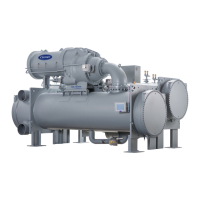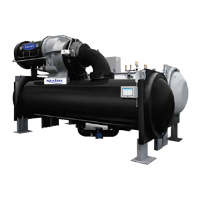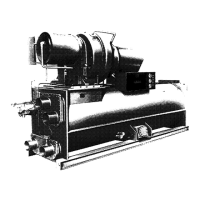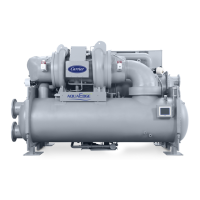Table 2 — CVC Display Data
IMPORTANT: The following notes apply to all Table 2
examples.
1. Only 12 lines of information appear on the CVC screen at any one
time. Press the NEXT
or PREVIOUS softkey to highlight a
point or to view items below or above the current screen. Press
the NEXT
softkey twice to page forward; press the
PREVIOUS
softkey twice to page back.
2. To access the information shown in Examples 9 through 21, enter
your 4-digit password after pressing the SERVICE
softkey. If
no softkeys are pressed for 15 minutes, the CVC automatically
logs off (to prevent unrestricted access to PIC II controls) and re-
verts to the default screen. If this happens, you must reenter your
password to access the tables shown in Examples 9 through 21.
3. Terms in the Description column of these tables are listed as they
appear on the CVC screen.
4. The CVC may be configured in English or Metric (SI) units using
the CVC CONFIGURATION screen. See the Service Operation
section, page 43, for instructions on making this change.
5. The items in the Reference Point Name column
do not appear on
the CVC screen
. They are data or variable names used in CCN or
Building Supervisor (BS) software. They are listed in these tables
as a convenience to the operator if it is necessary to cross ref-
erence CCN/BS documentation or use CCN/BS programs. For more
information, see the 19XR CCN literature.
6. Reference Point Names shown in these tables in all capital letters
can be read by CCN and BS software. Of these capitalized names,
those preceded by a dagger can also be changed (that is, written
to) by the CCN, BS, and the CVC. Capitalized Reference Point
Names preceded by two asterisks can be changed only from the
CVC. Reference Point Names in lower case type can be viewed
by CCN or BS only by viewing the whole table.
7. Alarms and Alerts: An asterisk
in the far right field of a CVC status
screen
indicates that the chiller is in an alarm state; an exclama-
tion point in the far right field of the CVC screen indicates an alert
state. The asterisk (or exclamation point) indicates that the value
on that line has exceeded (or is approaching) a limit. For more
information on alarms and alerts, see the Alarms and Alerts
section, page 14.
LEGEND
CCN — Carrier Comfort Network
CHW — Chilled Water
CHWR — Chilled Water Return
CHWS — Chilled Water Supply
CVC — Chiller Visual Control
CT — Current Transformer
ECW — Entering Chilled Water
HGBP — Hot Gas Bypass
ISM — Integrated Starter Module
LCW — Leaving Chilled Water
LRA — Locked Rotor Amps
mA — Milliamps
P—Pressure
SS — Solid State
T—Temperature
VFD — Variable Frequency Drive
WSM — Water System Manager
EXAMPLE 1 — CVC DEFAULT SCREEN
The following data is displayed in the CVC Default screen.
DESCRIPTION RANGE UNITS
REFERENCE POINT NAME
(ALARM HISTORY)
DISPLAY
(PRIMARY MESSAGE)
(SECONDARY MESSAGE)
(DATE AND TIME)
Compressor Ontime 0-500000.0 HOURS C
HRS
Entering Chilled Water −40-245 DEG F ECW CHW IN
Leaving Chilled Water −40-245 DEG F LCW CHW OUT
Evaporator Temperature −40-245 DEG F ERT EVAP REF
Entering Condenser Water −40-245 DEG F ECDW CDW IN
Leaving Condenser Water −40-245 DEG F LCDW CDW OUT
Condenser Temperature −40-245 DEG F CRT COND REF
Oil Pressure 0-420 PSI OILPD OILPRESS
Oil Sump Temp −40-245 DEG F OILT OIL TEMP
Average Line Current 0-999 % AMPS
% AMPS %
0-1 CCN
0-1 LOCAL
0-1 RESET
NOTE: The last three entries are used to indicate operating mode to the PIC II. These values may be forced by the CVC only.
21

